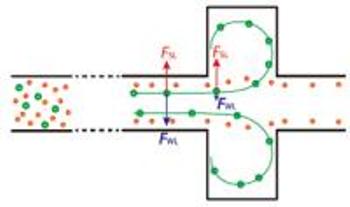Researchers at the University of Cincinnati have designed an inertial microfluidic device based on lab-on-a-chip technology to collect tumour cells based on their size.
 Device concept schematic for straight-channel inertial miccrofluidics. Lift and shear forces focus cells before the expansion or "crossroads." This balance is disrupted in the expansion region, leading to size-based cell trapping in the expansion.
Device concept schematic for straight-channel inertial miccrofluidics. Lift and shear forces focus cells before the expansion or "crossroads." This balance is disrupted in the expansion region, leading to size-based cell trapping in the expansion.
Collection of rare tumour cells that have very low concentrations in the blood is extremely difficult and largely depends on the biomarkers available on the cells.
Researchers tested the spiral and straight channels of microfluidic lab-on-a-chip devices. Sample introduction in the spiral channel involved inserting a sample at the centre of the spiral. Under this method though the cells were separated by focussing them into individual steams, it was impossible to separate prostate cells or cells with low concentration. To counter this problem, researchers came up with the straight channel inertial microfluidic lab-on-a-chip device. Under this method the sample is inserted through a syringe into a channel as thin as the human hair. Before the cells actually expand, they are isolated into separate groups near the sidewalls by the balance of shear and lift forces. The balance force gets disturbed at the expansion point of the cells and makes the prostrate cancer cells that are large cells to move sideways into the expanded areas. These isolated cells can be used for experiments later on.
This method can be used to separate cells which are present in the blood at the lowest concentration rate of one cell per millilitre of blood. However care has to be taken to apply the right kind of balance and lift force so that the cells are not damaged. This method can also be used on all types and sizes of cells. The research team has already acquired a provisional patent and will soon receive a full patent for this technology.
Source: http://www.uc.edu